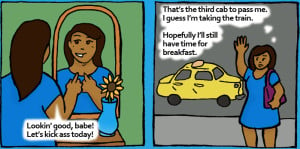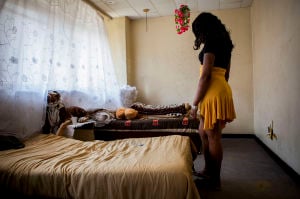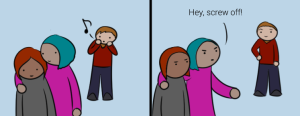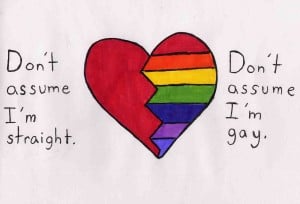
Source: The Lizness
Can you think of a movie or television show that portrays abortion as an option for one of its characters?
Do you remember how the plot developed from there? What consequences were in store for that character?
According to a recent study on abortion-related storylines in American television shows and films, when abortion is considered by a character, 14 percent of storylines see that character ultimately die, regardless of whether or not she chooses to have an abortion.
Sixty percent of the deaths are caused by the procedure itself. After that, the deaths are most often caused by murder or suicide.
So what do our dominant narratives say about abortion?
It’s a risky procedure wrought with moral and social stigma carrying significant consequences, one potentially being death.
But what is the actual risk of death by abortion? Less than 0.05%.
Quite literally, your chance of dying from a first-trimester abortion is one in a million.
The dominant narrative also tells us that abortion is rare – only a very small percentage of pregnancy stories include abortion as an option when unintended pregnancies occur.
In reality, abortion is incredibly common: one in three women will have had an abortion by the time they are 45.
These are the dominant narratives about abortion – the stories we see and hear that shape how we perceive the procedure.
Meanwhile, where are the real stories? Where are the facts and the lived experiences of actual people having abortions?
Stigma and Silence
Heavily politicized as reproductive rights are, new legislation is constantly being introduced to create financial and physical barriers to a woman’s legal right to an abortion.
From the closing of clinics due to arbitrary laws about door heights and parking lots, to the increase in laws requiring waiting periods and ultrasounds, abortion is becoming increasingly more difficult to access, particularly for low-income women.
This anti-abortion political landscape is supported by the assumption that abortions are a dangerous procedure that a small minority of (immoral, selfish) women is getting.
The stigmatization (both of the procedure, and the women who choose it) is fed by the media – in television, film, and news stories.
But this narrative couldn’t be any farther from the truth.
Most people aren’t aware that abortion is actually one of the safest and most common medical procedures.
If one-in-three women has had an abortion, where are their stories?
There are few public spaces where people feel safe to tell their stories about abortion, and the political, religious, and social stigma surrounding abortion only increases in this silence.
People aren’t encouraged to share their abortion stories; quite the opposite, they are encouraged to keep their stories to themselves.
Although abortion has been legal for more than 40 years now, the cultural stigma of abortion tells us abortion experiences are to be kept secret and private.
This silence is hurtful to each person who chooses to have an abortion or considers one.
The stigma isolates us, leaving everyone affected, and many ashamed, confused, and unaware that so many around them share their experiences.
Media Archetypes and Myths
When the stories of real people aren’t being heard, the archetypes perpetuated by American media and politics carry a lot of weight in shaping our perceptions around the procedure.
What are the dominant archetypes of women considering abortion?
A popular archetype in fictional television is the struggling teenager – the high school student who accidentally becomes pregnant and must bear the weight of shame in regard to her sexual choices.
Despite the predominance of this narrative, only 18 percent of abortions are obtained by teenagers. (Though this does not diminish the need to support abortion access for girls under 18!)
The dominant narrative also makes assumptions about parenthood: It is commonly thought that abortions are primarily chosen by those who do not want to be parents.
The stigma of choosing abortion says it is a selfish choice, and anti-abortion advocates place mothers at the top of the moral hierarchy, allowing these categories to be perceived as mutually exclusive.
In reality, the majority of those who have abortions are mothers.
According to the Guttmacher Institute, 61 percent of those who choose abortion already have at least one child, and many cite their children as the reason for their abortion.
Another archetype, one perpetuated quite often by anti-abortion politicians and activists, is the concept of someone using abortion as birth control.
This image of a villianized, careless woman who obtains countless abortions due to overall laziness and hypersexuality is based on many false assumptions, one being that abortions are easy to get.
It follows, as many of these archetypes do, an overall cultural demonization of female sexuality.
Our media, in its tendency to oversimplify experiences, particularly those of women, tends to either demonize or victimize women and girls, particularly when it comes to female sexuality.
These stories show us what happens when a girl or woman engages in sex and isn’t prepared to deal with the consequences.
Abortion deeply intersects with how our culture perceives and treats sexuality and motherhood. As we saw in the above study, when a character even considers an abortion on television, her likelihood of death skyrockets.
What kinds of dangerous subconscious link does this then create in the minds of viewers?
Even when characters don’t die, they struggle. And this is the larger perception of abortion in our culture: that having an abortion is always an emotionally difficult, guilt-ridden, traumatic experience.
Abortion is scary, we’re told – the procedure, the decision to have one, and the weight of silence that one who obtains an abortion must carry throughout their lives.
This cultural production of what an abortion experience is supposed to be like has no doubt created scary experiences for countless women, as those making this decision often have no stories based in reality to gauge what their experiences will/should be.
So What Are Abortions Actually Like?
Abortions aren’t actually like anything in particular.
For some, abortions aren’t a difficult decision or experience at all.
For others, they are extremely difficult, either financially, emotionally, or both.
For most, it is a combination of the two – a complex symbiosis of emotions: relief, guilt, joy, shame, independence, stigma, empowerment.
Just like people undergoing any other medical procedure, those who have abortions experience a whole range of feelings based on where they are in their lives, their support system, their insurance and medical access, and their own relationship to the procedure.
Unlike any other medical procedure, abortion carries a whole mess of moral and ethical stigma, making the experience far more difficult than it needs to be.
But for the overwhelming majority – 90 percent of those who obtained an abortion, the overarching feeling they have afterward is relief.
Intersecting Identities of Oppression Increase Stigma
When we talk about abortion, who are we talking about? We use the terms “women” and “girls” because it helps draw attention to the fact that gender oppression is at the root of stigma and inaccessibility to abortions.
But there’s a problem when we talk about reproductive rights as if women and girls are the only people who get abortions.
Trans men and other trans* people also get abortions. And for trans* folks, the stigma is even higher, as it is for everyone else who experiences multiple layers of oppression.
Low-income and working-class women experience a higher stigma around abortion, and have the hardest time accessing it.
Women of color, particularly Black women, are often faced with a racially charged stigma as (both White and Black) anti-abortion activists argue that abortion is “Black Genocide,” advertising on billboards in Black neighborhoods that “the most dangerous place for an African-American is in the womb.”
We should work to understand, as we work to battle stigma around abortion, how that stigma exponentially increases for people who already experience marginalization and oppression in society.
Such a large part of the negative emotions experienced by those obtaining an abortion are caused directly by the cultural stigma surrounding it.
How can we work to alleviate that stigma?
What Can We Do?
1. Create Safe Spaces
We can work to create safe spaces where people feel encouraged to share their own stories – and not just those who have had an abortion but all those who have had an abortion experience: parents, partners, friends.
In creating these safe spaces, we can work to make these stories heard, making it safer and easier for others to speak and to feel more supported if they choose to have an abortion.
More and more, campuses and communities around the country are organizing abortion speak-outs and similar events meant to encourage and empower folks to tell their stories.
Advocates for Youth’s 1 in 3 Campaign helps to share these stories through video and social media, and has toolkits for promoting supportive spaces and abortion access.
2. Promote Realistic Portrayals in Media
Because media shape our perceptions of experiences, we must also work to create more realistic and sympathetic portrayals of abortion stories in American media.
Comedian Jenny Slate and friends are doing just that in their movie Obvious Child, set to release sometime this year.
By sharing honest, accurate, and relatable stories about abortion in television and movies, we can work to counter the dominant narrative that villianizes, victimizes, and oversimplifies abortion experiences.
3. De-Stigmatize the Word
Despite major forward steps in the abortion rights movement in numbers, reach, and inclusivity, there seems to be a backward motion in regards to the word ‘abortion.’
Following the anti-abortion movement’s lead in stigmatizing the procedure as well as the word, more and more abortion rights advocacy groups are sticking strictly to the word ‘choice.’
NARAL, for example, whose acronym originally stood for National Abortion Rights Action League, changed its name in 2003 to NARAL Pro-Choice America as a marketing move, a new brand that many organizations, as well as political campaigns and grassroots activists, have followed. Who can say no to “choice,” right?
This is a political strategy, and one can that can be effective at achieving certain short-term goals. But in the long run, when we shy away from the word abortion, it only serves to further stigmatize it and hurt our cause.
If abortion rights advocates aren’t willing to use the word abortion, who will?
4. Share Our Stories
Have you had an abortion? Share your story with your friends, if you’re comfortable doing so.
When I began talking about my abortion to my friends, I learned that many of them had also had one. Sometimes it just takes one person sharing their story to make others feel comfortable to share their stories as well.
When there is such a limited space to talk about abortion in society, the fictional stories we see and the dominant political discourses we hear and participate in become what we think we know about abortion, and this not only affects how we as a culture perceive it, but how the political landscape reacts and blocks access to reproductive rights.
When abortion is portrayed and perceived as unsafe, it is much easier for legislators to gain public support for measures that make abortions more difficult to get.
When we share our stories, we not only show how common and complex abortion experiences are, we also serve to highlight the realities of abortion – who gets abortions, what they’re actually like, and the issues we face in gaining full abortion access.
When we tell our stories, we put names, faces and real lives to this “mythical procedure,” basing it in reality and working to de-stigmatize abortion as a part of a growing effort to make abortion experiences emotionally healthy, supportive and fully accessible to all.
[ultimatesocial_facebook custom_class=”fb-btn-us”] [ultimatesocial_twitter custom_class=”tw-btn-us”]
Want to discuss this further? Login to our online forum and start a post! If you’re not already registered as a forum user, please register first here.
Laura Kacere is a Contributing Writer for Everyday Feminism and is an feminist activist, social justice organizer, clinic escort, and yogi living in Washington, D.C. Laura coordinates the Washington Area Clinic Defense Task Force, teaches yoga with the intent of making it accessible to all, and does outreach for the DC-based sex worker support organization, HIPS. When she isn’t on her mat or at the clinic, she’s usually thinking about zombies, playing violin, eating Lebanese food, and wishing she had a cat. Follow her on Twitter @Feminist_Oryx. Read her articles here.
Search our 3000+ articles!
Read our articles about:
Our online racial justice training
Used by hundreds of universities, non-profits, and businesses.
Click to learn more




















